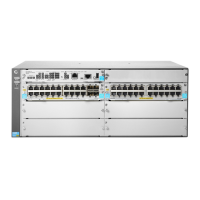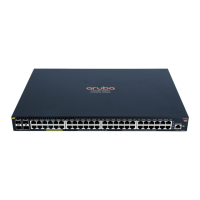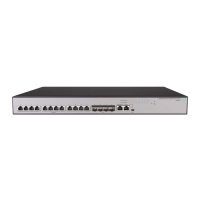89
To configure the path cost of a port:
Step Command Remarks
1. Enter system view.
system-view
N/A
2. Enter Layer 2 Ethernet or
aggregate interface view.
interface
interface-type
interface-number
N/A
3. Configure the path cost of
the ports.
• In STP/RSTP mode:
stp cost cost
• In PVST mode:
stp vlan vlan-id-list cost cost
• In MSTP mode:
stp [ instance instance-list ] cost
cost
By default, the system
automatically calculates
the path cost of each port.
Configuration example
# In MSTP mode, perform the following tasks:
• Configure the device to calculate the default path costs of its ports by using IEEE 802.1d-1998.
• Set the path cost of GigabitEthernet 1/0/3 to 200 on MSTI 2.
<Sysname> system-view
[Sysname] stp pathcost-standard dot1d-1998
Cost of every port will be reset and automatically re-calculated after you change the
current pathcost standard. Continue?[Y/N]:y
Cost of every port has been re-calculated.
[Sysname] interface gigabitethernet 1/0/3
[Sysname-GigabitEthernet1/0/3] stp instance 2 cost 200
# In PVST mode, perform the following tasks:
• Configure the device to calculate the default path costs of its ports by using IEEE 802.1d-1998.
• Set the path cost of GigabitEthernet 1/0/3 to 2000 on VLAN 20 through VLAN 30.
<Sysname> system-view
[Sysname] stp pathcost-standard dot1d-1998
Cost of every port will be reset and automatically re-calculated after you change the
current pathcost standard. Continue?[Y/N]:y
Cost of every port has been re-calculated
[Sysname] interface gigabitethernet 1/0/3
[Sysname-GigabitEthernet1/0/3] stp vlan 20 to 30 cost 2000
Configuring the port priority
The priority of a port is a factor that determines whether the port can be elected as the root port of a
device. If all other conditions are the same, the port with the highest priority is elected as the root
port.
On a spanning tree device, a port can have different priorities and play different roles in different
spanning trees. As a result, data of different VLANs can be propagated along different physical paths,
implementing per-VLAN load balancing. You can set port priority values based on the actual
networking requirements.
When the priority of a port changes, the system recalculates the port role and initiates a state
transition.

